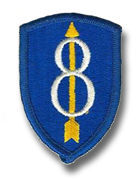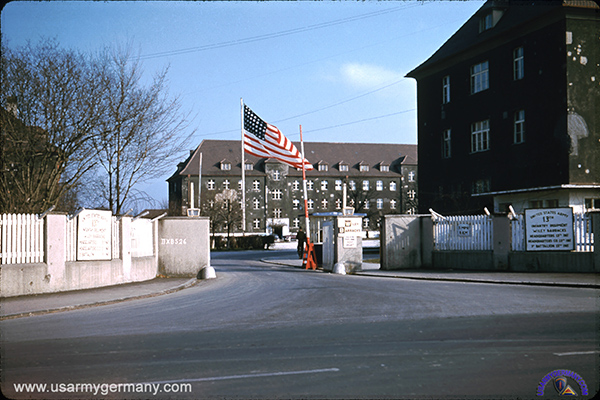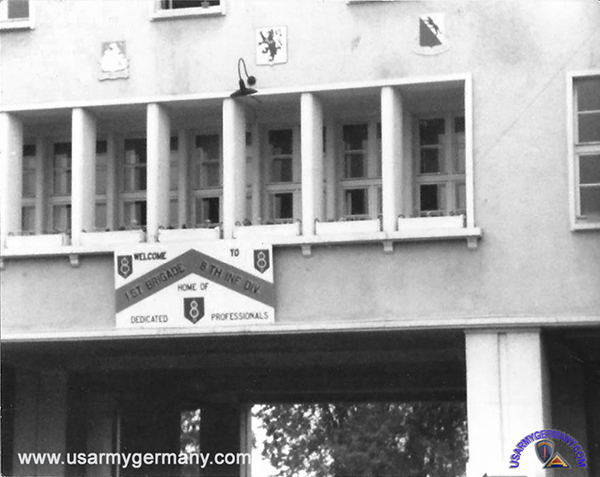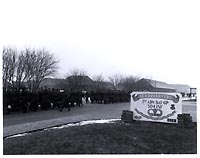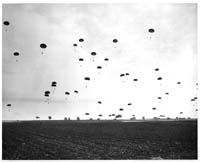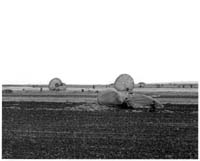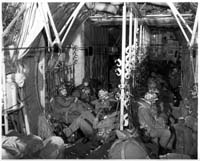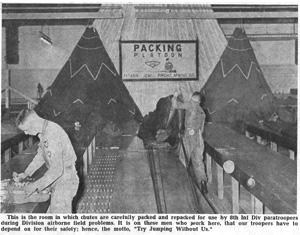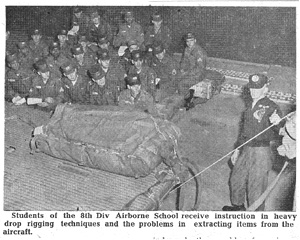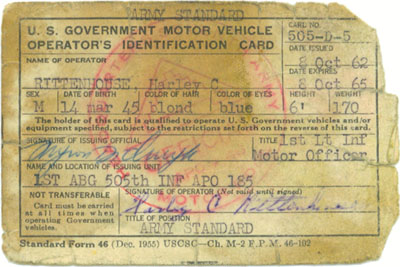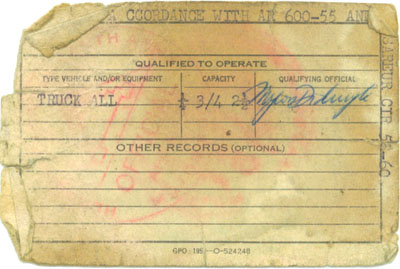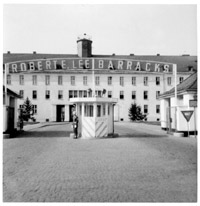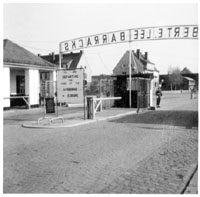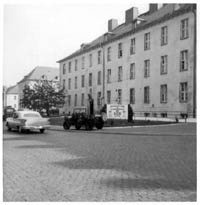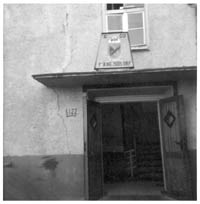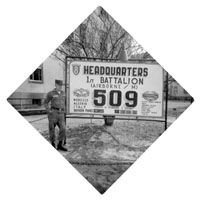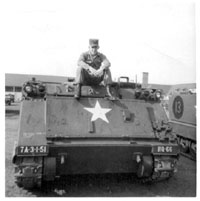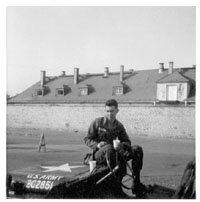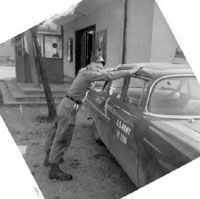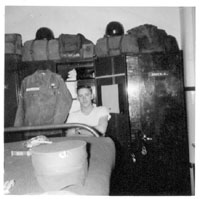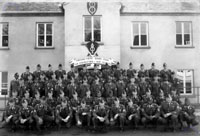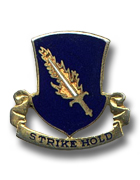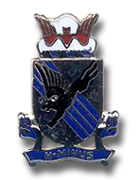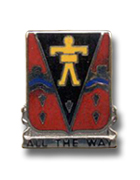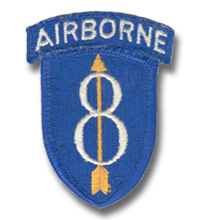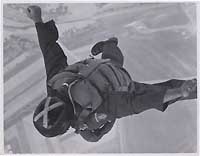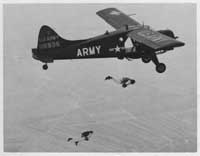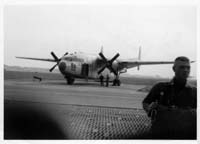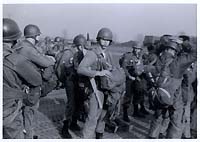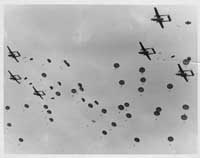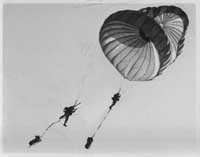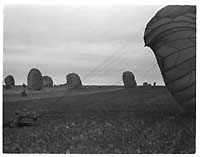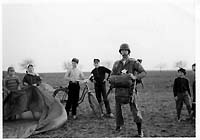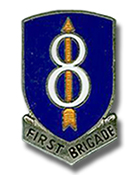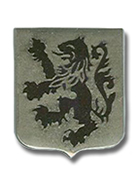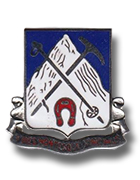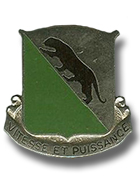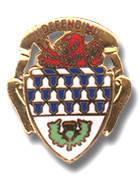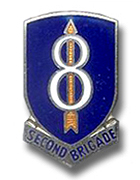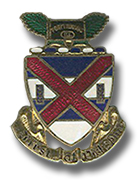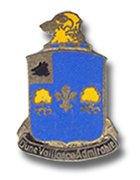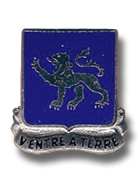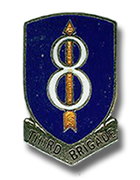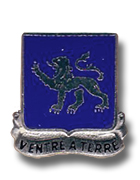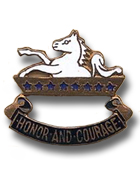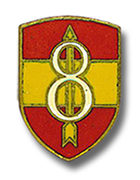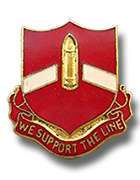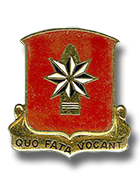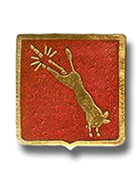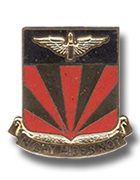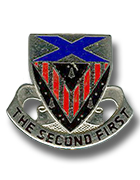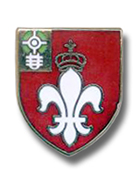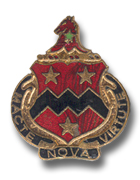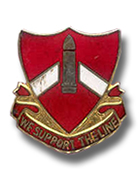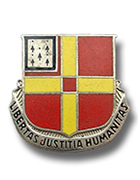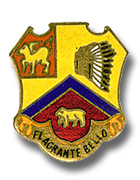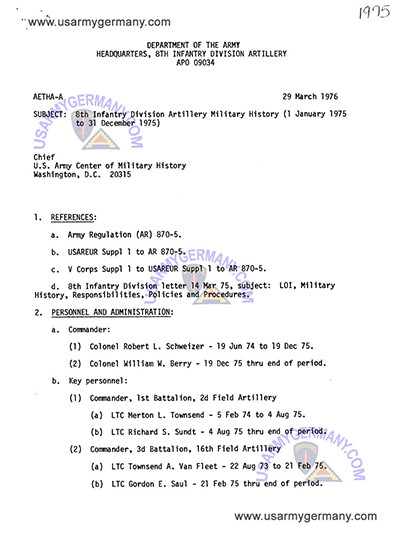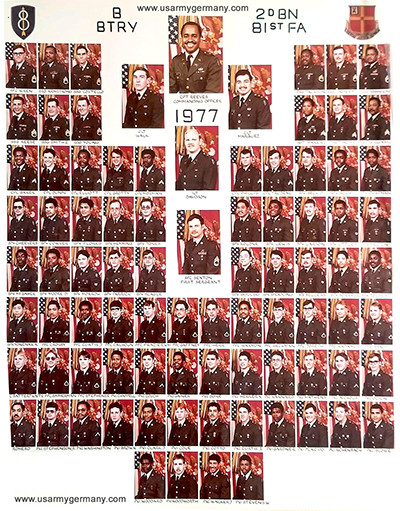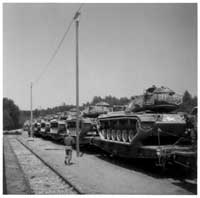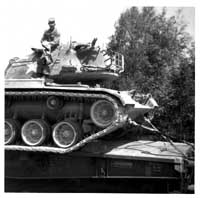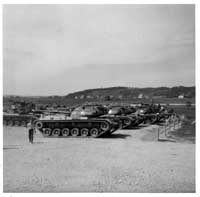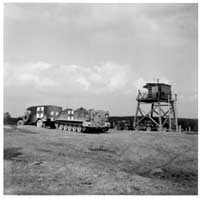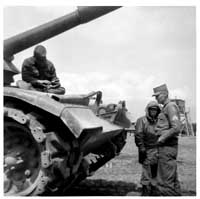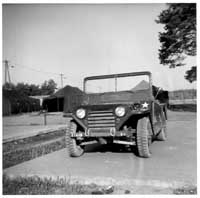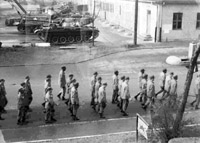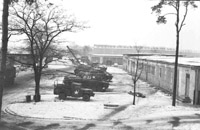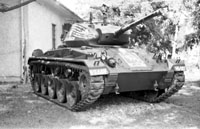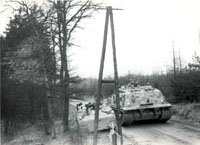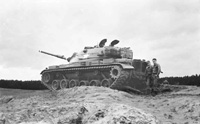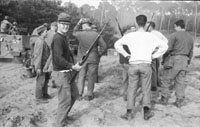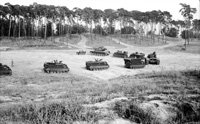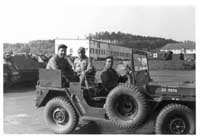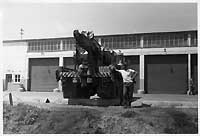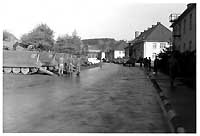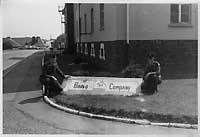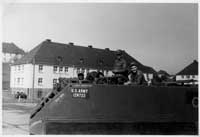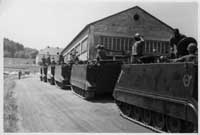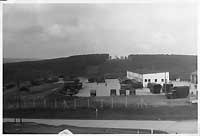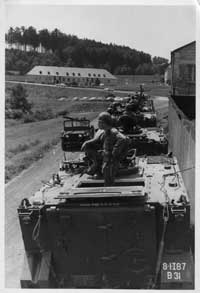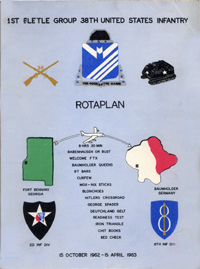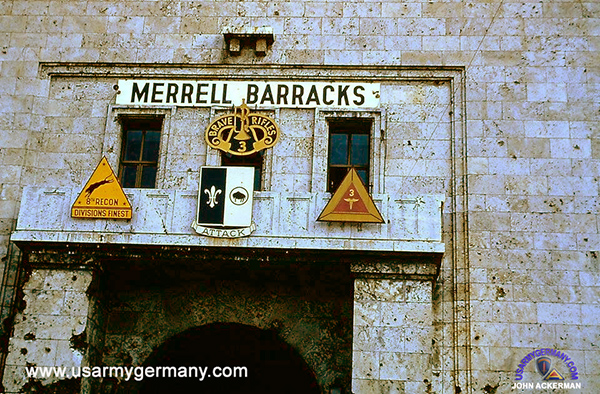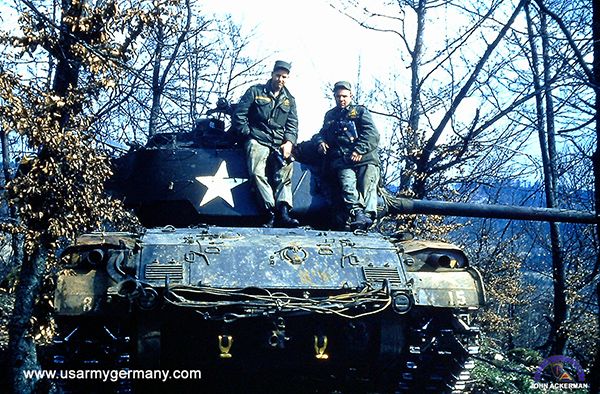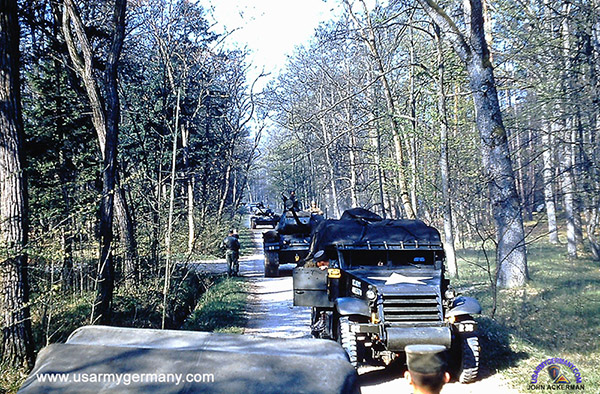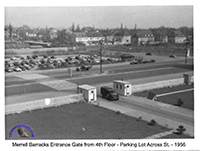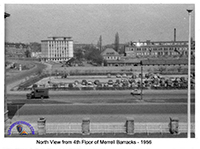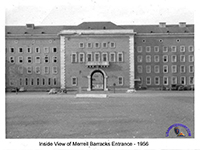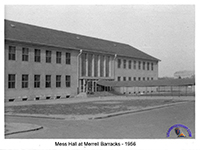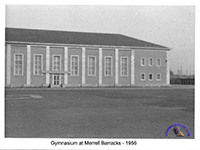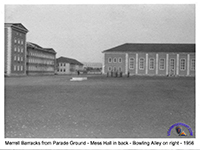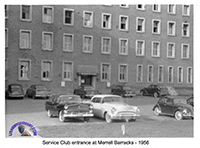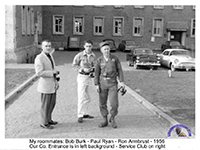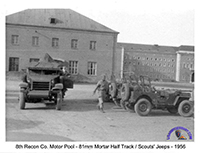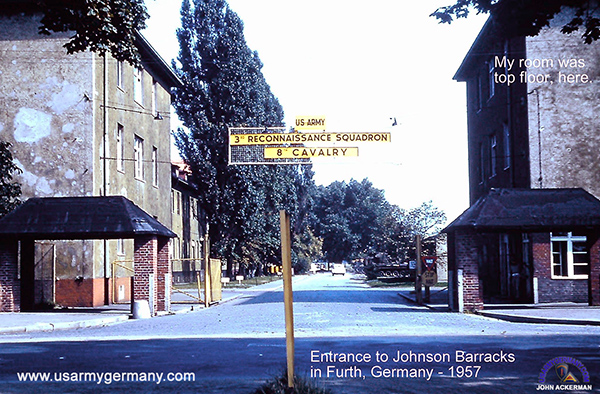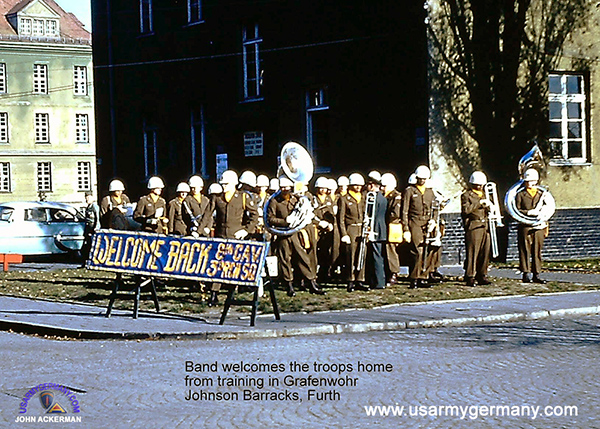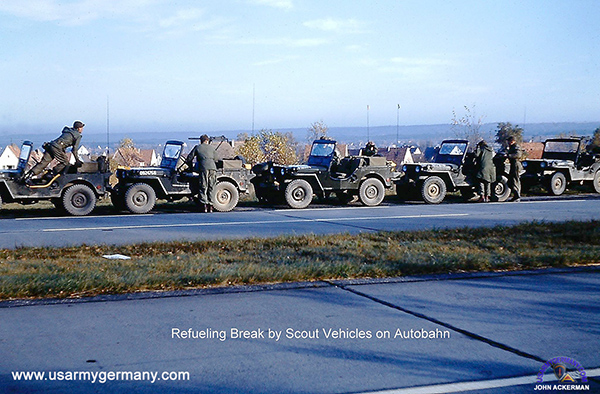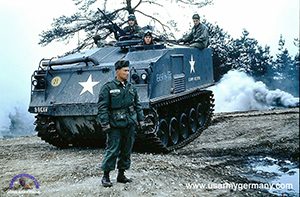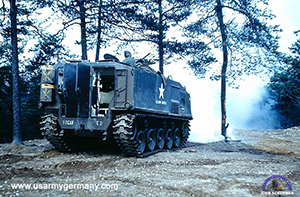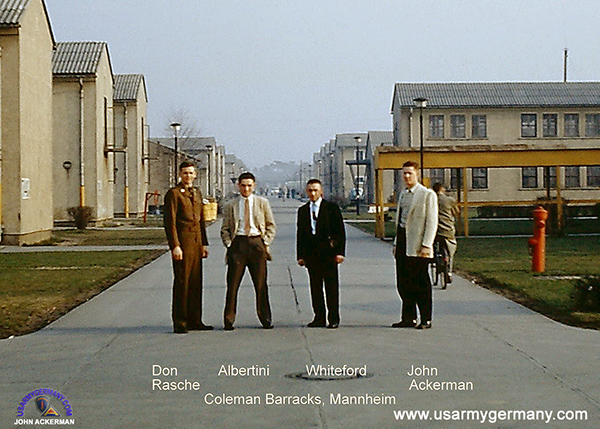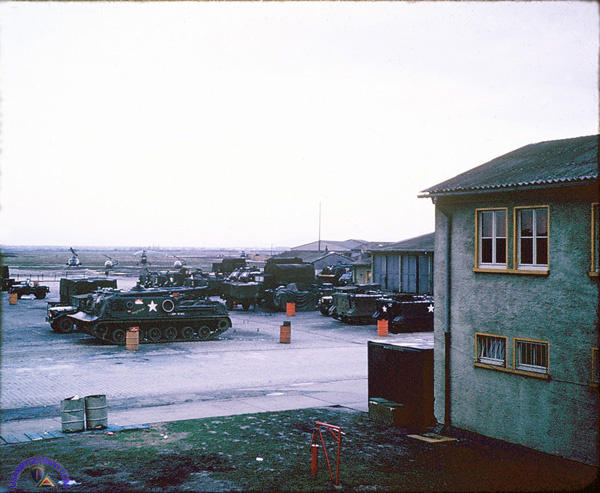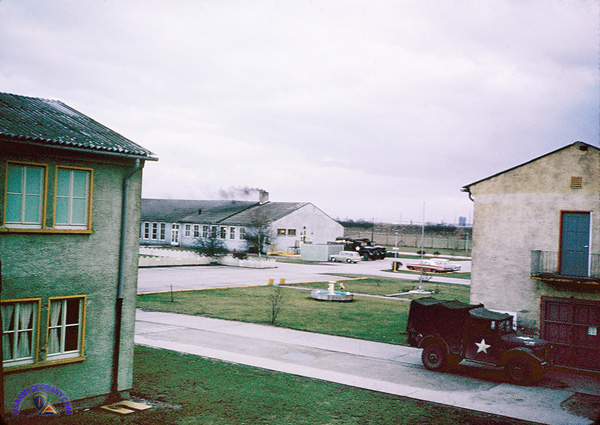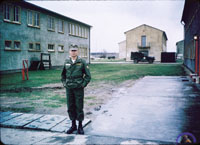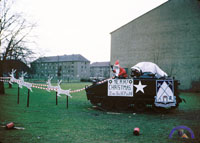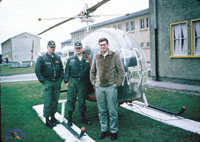| If you do NOT see the Table of Contents frame to the left of this page, then Click here to open 'USArmyGermany' frameset |
||||||||||||||||||||||||||||||||||||||||
8th Infantry Division (Mech) |
||||||||||||||||||||||||||||||||||||||||
|
|
||||||||||||||||||||||||||||||||||||||||
|
||||||||||||||||||||||||||||||||||||||||
|
|
||||||||||||||||||||||||||||||||||||||||
| 13th Infantry Regiment | ||||||||||||||||||||||||||||||||||||||||
| (Source: Email from Chuck Charnquist) | ||||||||||||||||||||||||||||||||||||||||
| Background: Served with Med Co, 13th Regiment, 8th Infantry Division, Wiley Barracks, Neu-Ulm, Germany, from Sep 1956 to July 1957. Click here and here to see additional Old Wiley pics submitted by Chuck. |
||||||||||||||||||||||||||||||||||||||||
| 1st Brigade (Airborne) | ||||||||||||||||||||||||||||||||||||||||
| 1958 - 1973 | ||||||||||||||||||||||||||||||||||||||||
| (Source: Annual Historical Report, 1958-59, HQ USAREUR) | ||||||||||||||||||||||||||||||||||||||||
| The Restationing of the Airborne Battle Groups On 1 July 1958, the 11th Airborne Division was redesignated as the 24th Infantry Division. The division remained responsible for providing the airborne elements of Army Task Force 201, consisting of two airborne battle groups, a composite artillery battalion, and a quartermaster parachute company. To enable the 24th Division to comply with this requirement, it was organized as a composite division with a strength of 14,311, whereas the standard infantry division was composed of 13,580 personnel. At the time of the Lebanon operation, when part of ATF 201 was deployed to the Middle East and the 24th Division was reduced by over 2,200 personnel, plans were prepared to shift the burden of supporting the task force to the 8th Infantry Division, which was earmarked as the reserve division. The potential reduction in the combat capability of the reserve was considered as the lesser of two evils. But the entire problem would be eliminated if the Department of the Army approved General Hodes' recommendation to transfer the primary Army responsibility for supporting contingency plans in the Middle East to the Strategic Army Corps in the United States. However, the Department of the Army not only refused to relieve USAREUR of its Middle East support mission, but also indicated that the planned gyroscope of the 504th and 505th Airborne Battle Groups could not be canceled. As a result, the 8th Infantry Division was reorganized as a composite division on 1 December 1958, so that it could assume the airborne support responsibility hitherto held by the 24th Infantry Division. On 21 December 1958, the 504th Airborne Battle Group of the 8th Division replaced the 503rd Abn BG of the 24th Division as Force BRAVO and one month later the 505th Abn BG of the 8th Division relieved the 187th Abn BG of the 24th Division as Force ALPHA. On 5 February 1959, the 24th Infantry Division was reorganized as a standard infantry division. |
||||||||||||||||||||||||||||||||||||||||
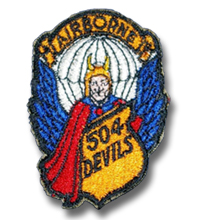 504th Airborne Infantry Regiment patch (1957-1959) 504th Airborne Infantry Regiment patch (1957-1959) |
||||||||||||||||||||||||||||||||||||||||
| Airborne units assigned to the 8th Infantry Division in the PENTOMIC configuration (1958-1963): | ||||||||||||||||||||||||||||||||||||||||
|
||||||||||||||||||||||||||||||||||||||||
| [1] The unit was redesignated as the 1st Airborne Battle Group, 504th Infantry on 1 September 1957. On 12 December 1958, the 1/504 became part of the 8th Infantry Division and was based at Lee Barracks, in Mainz-Gonsenheim, Germany. On 1 April 1963, the battalion was relieved from assignment to the 8th Inf Div and assigned to the 82nd ABN Div. [2] Co A, 505th Abn Inf was reorganized and redesignated as the 1st Airborne Battle Group, 505th Infantry on 1 September 1957. On 15 January 1959, the 1/505 became a part of the 8th Infantry Division and was based at Lee Barracks, in Mainz-Gonsenheim, Germany. On 1 April 1963, the battalion was relieved from assignment to the 8th Inf Div and assigned to the 82nd ABN Div. [3] It appears that some or all airborne units moved to Rhein Kaserne in Biebrich (Wiesbaden) at some point, maybe during the Berlin Crisis, 1961. |
||||||||||||||||||||||||||||||||||||||||
|
||||||||||||||||||||||||||||||||||||||||
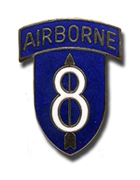 Airborne Brigade DI Airborne Brigade DI |
||||||||||||||||||||||||||||||||||||||||
| Airborne units assigned to the 8th Infantry Division in the ROAD configuration (1963-1973): | ||||||||||||||||||||||||||||||||||||||||
|
||||||||||||||||||||||||||||||||||||||||
| [1] On 27 March 1963, Co A, 509th Parachute Infantry Battalion was redesignated as HHC, 1st Bn, 509th Inf and assigned to the 8th Inf Div (organic elements concurrently constituted). The Battalion was activated on 1 April 1963 in Germany. [2] On 27 March 1963, Co B, 509th Parachute Infantry Battalion was redesignated as HHC, 2nd Bn, 509th Inf and assigned to the 8th Inf Div (organic elements concurrently constituted). The Battalion was activated on 1 April 1963 in Germany. |
||||||||||||||||||||||||||||||||||||||||
| In 1973, the existing 1st and 2nd Battalions of the 509th Infantry were replaced by two mechanized infantry battalions (2d Bn, 28th Inf and 2d Bn, 87th Inf) which brought the 8th Infantry Division to fully mechanized status and provided it with the enhanced cability to defend Central Europe, its primary task. To provide greater mobility to the Mediterranean area, the 1st Battalion of the 509th Infantry (ABCT) was assigned to Vicenza, Italy. | ||||||||||||||||||||||||||||||||||||||||
| (Source: Special Organization Day 1960 Issue of the ARROW, 8th Inf Div newspaper, July 1, 1960), | ||||||||||||||||||||||||||||||||||||||||
| 1st Airborne Battle Group, 504th Infantry | ||||||||||||||||||||||||||||||||||||||||
| After years of training in the States, the regiment was reorganized under current concepts and redesignated as the 1st Airborne Battle Group, 504th Infantry. During World War II, troopers of the 504th earned one Medal of Honor, 20 Distinguished Service Crosses, 200 Silver Stars, 2,972 Purple Hearts, and were awarded the Belgium Fourragere and the Netherlands Orange Lanyard. In addition to it's three combat jumps, (Sicily, Salerno and Holland), the 504th participated at Naples-Foggia-Anzio, Ardennes-Alsace, Central Europe and Rhineland. It is interesting to note that the Regiment fought 14,000 miles through 11 countries with 365 days in actual combat. In April 1958, the 504th was alerted for its gyroscope move to Germany and in December, 1958, became a member of the 8th Inf Div. The first large scale airborne exercise in which the unit participated as part of the 8th Div, was "Arrow Drop." In November, 1959, the "Devils" were the airborne striking force in Exercise "Heaven Sent," where in a matter of minutes the entire unit had jumped and assembled into position to complete their part in one of the largest tactical airborne operations in Europe since World War II. Continuing their intensive training the 504th "Devils" spearheaded operation "Fer De Lance," an exercise designed to test the effectiveness of small airborne units deployed on isolated missions in unfamiliar territory during hours of limited visibility. This operation was conducted at Pau, France. In the final weeks of FY 1960 the 504th "Devils," commanded by Co! Joseph B. Seay, again demonstrated their combat readiness when they, along with other units of the 8th Div Airborne Brigade, participated in "Operation Fleche d'Or." As a result of their continual rugged training and insurmountable pride in being paratroopers of the 8th Inf Div, the "Devils" of the 504th are today, as always, prepared to "Strike-Hold" which is the motto inscribed on the 504th's distinguished Blue Shield, below the flaming sword. |
||||||||||||||||||||||||||||||||||||||||
| 1st Airborne Battle Group, 505th Infantry | ||||||||||||||||||||||||||||||||||||||||
| In Sept., 1957, the 505th Airborne Infantry Regiment was reactivated under the current concepts and re-designated as the 1st Airborne Battle Group, 505th Infantry. January 1959, the Panthers again returned to Germany, this time as a part of the 8th Div's Airborne striking force. It was the 5O5th's first return to this soil since the 1946 Berlin Honor Guard assignment. Highlighting the year 1959, the distinguished unit represented the United States Army in the 10th Anniversary NATO Parade held in Mainz, Germany. Ten other countries participated in the huge spectacle, the largest international military parade in modern history. In Sept., 1959, the 505th welcomed a new commander, Col Theodore C. Mataxis, who had served formerly as the 8th Div Chief of Staff and Dep Brigade CO. At a colorful change of command ceremonies the 1500 man battle group honored Col Lamar A. (Bill) Welch with a departing parade as he passed the colors to Col Mataxis. 1960 started another cycle of training for the Panthers with renewed vigor and seasoned interest. In Baumholder, the unit underwent two weeks of intensive training topped off by a three-day field exercise. Cold as it was, the unit proved that effectiveness cannot be crushed by snow and ice. The 505th lot jumped over Pau, near the Pyrennes, at the rate of a company a day, consuming over 121 flight hours and 33 aircraft flights. This exercise marked the first long range airborne exercise held in USAREUR. For the second consecutive year the Panthers won the Division Le Clerc matches, outshooting their opponents by 200 points. They then went on to win the Corps, Le Clerc matches. Airborne exercises continued to fill the schedule. Two weeks after the Pau exercise the Panthers jumped nearly 1500 troopers in two lifts over the Leipheim drop zone in South Germany in Operation "Devil's Claw." Early in May preparations were made for participation in the largest joint airborne exercise conducted to date, "Exercise Fleche d'Or." On May 19th 505th Infantrymen jumped from the first of 33 aircraft over Haguenau, France. Ste Mere Eglise, France, June 6, 1960: The veterans of the 505th returned to this small village on the Normandy peninsula for the second year. Greeted by the entire throng of 1200 citizens, the troopers arrived by helicopters. Again living with the families, they reminisced the many heroic events of the village's liberation. Other notable accomplishments of the Panthers during early 1960 include: 903 blood donations to the Landstuhl Blood Bank, the largest donation by any unit in the past eight years. |
||||||||||||||||||||||||||||||||||||||||
| 11th Quartermaster Company (Parachute Supply & Maintenance) | ||||||||||||||||||||||||||||||||||||||||
|
||||||||||||||||||||||||||||||||||||||||
| The 11th QM PS & M was constituted on Oct. 28, 1944, as the 11th Parachute Maintenance Co at Oro Bay, New Guinea, and later redesignated as the 11th QM PS & M Co on Mar. 1, 1957. Prior to joining the 8th Inf Div in Jan., 1959, the unit was part of the 24th Div. Previously, while a member of the 11th Abn Div, the Company participated in the Libanon movement and maintained parachute packing facalities for the paratroopers duriing their stay there. Proud of their motto, "Try Jumping Without Us," the members of the 11th Prcht Main Co are qualified parachutists who have earned the right to wear the red cap with wings distinguishing them as parachute riggers. Each rigger has been thoroughly schooled on inspection and classification of equipment, and how to repair and operate the equipment. The Company is composed of several sections and platoons, one of which is the Hqs Section, which is responsible for the administration, operation, mess management supply and motor maintenance. The Aerial Delivery Platoon has the responsibility of packing the cargo chutes for the support of the Abn units. The Maintenance Platoon is responsible for maintaining the several thousand items of equipment and parachutes. The Parachute Packing Platoon is the group into whose hands are entrusted the lives of all parachutists each time they step from the door of an aircraft. Every parachute is inspected each time it is packed, and the names of the packer and inspector are listed in the log book. The members of this platoon do not take their responsibility lightly and this is proven by the parachute malfunction record. During the four years that the Company has been in Germany, a total of over 200,000 parachute jumps have been made. Of this huge total, only nine injuries were due to parachute malfunction, none of which were due to improper packing. Every rigger is proud of the responsibility that is entrusted him. In addition he is prepared to prove the quality of his packing. Riggers regard their duties as a profession, not merely a "job". This is part of the code by which the riggers work, to be ready to jump with any of the parachutes they pack. |
||||||||||||||||||||||||||||||||||||||||
| 8th Division Airborne School | ||||||||||||||||||||||||||||||||||||||||
|
||||||||||||||||||||||||||||||||||||||||
| In anticipation of the arrival of the 504th and 505th Abn Infs, the Airborne School was assigned to the 8th Division in the later part of 1958. At that time the cadre consisted of personnel who originally taught at the now deactivated 11th Abn Div Jump School. As the instructors from the 11th Abn began rotating, they were replaced by personnel from the 504th and 505th, many of whom had taught at the 82d, 101st, or Fort Benning Jump Schools. With this blending of experience, the 8th Inf Div Airborne School has one of the finest staffs of airborne instructors in the world. The majority of the 1400 students who have been graduated from the school since its inception have attended only one of the seven courses taught at the school. Before he is permitted to jump, a soldier goes through a rigorous two-week period of pre-jump training in which he must meet the standards required of an airborne soldier. The training a student receives during this period is drilled into him so rigorously that the essential elements of parachuting are ineffaceably impressed upon him. But, in many cases, there is usually a period in which an airborne soldier serves, either in isolated duty, or in a non-airborne outfit. The purpose of refresher training is to re-familiarize the individual with basic precepts of parachuting, and to introduce him to the newest inovations in the ever changing forms of modern airborne techniques. Every plane load of airborne troops is controlled by one individual who is designated as the jumpmaster. Because of the various types of aircraft used and the many forms of equipment dropped with personnel, the responsibilities of the jumpmaster are many and encompass a wide range of topics. All the knowledge required to jumpmaster an aircraft is taught at the Airborne School with graduate work given in jumpmaster refresher courses to keep qualified men up to date with current changes. There are two courses taught at the Airborne School dealing with the different types of aircraft used by the 8th Inf Div, including both Army and Air Force aircraft. The purpose of these courses is to impart sufficient knowledge to key officers and NCOs in all units of the Division so that each unit is independently capable of moving its personnel and equipment by either Army or Air Force aircraft. The terminal guidance course taught at the Airborne School corresponds to the duties of the Pathfinder in parachute operations. As the Air Force Pathfinder sets up a drop zone for a parachute jump, the Army Pathfinder establishes a landing zone for airmobile operations. Aerial Delivery of supplies is another course taught at the school. There are many inaccessible areas in which the only possible source of re-supply would be from the air, by parachute. Supplies ranging from plasma to D-4 bulldozers are now available much faster than ever before. Rigging these supplies for heavy drop and familiarization with Air Force aircraft are a few of the important factors making up this course. At all times there is a constant awareness that each course of instruction will readily attest to its effectiveness for, after completion of each course, students are asked to evaluate the instruction and offer recommendations for improvement. The ability to air move a unit is gained only through the personal efforts of each individual and the Division's ability to perform well in this respect rests primarily on the shoulders of the cadre at the Airborne School. In all their instruction, the cadre keep one fact in mind:"Future combat operation will be won by the most highly trained forces." |
||||||||||||||||||||||||||||||||||||||||
| (Source: Email from Carl C. Rittenhouse, son of Harley C. Rittenhouse, 1st Abn BG, 505th Inf, 1962-64) | ||||||||||||||||||||||||||||||||||||||||
| You were requesting pictures of the 505 and 509 assigned to the 8th INF in Germany. My father was stationed over there from 1962 to 1964. He was in the 505 and was there when it changed over to the 509 in April of 63. In early 64 he was reassigned to the 48 INF (a leg unit) then came home. He was proud to be Airborne. He reentered the service in 1978 and went full time in 1980, he retired this year. Enclosed are some pictures of him and friends in Germany. My fater and his cousin went to Jump School together in 1962 and both were sent to Germany. |
||||||||||||||||||||||||||||||||||||||||
|
||||||||||||||||||||||||||||||||||||||||
|
||||||||||||||||||||||||||||||||||||||||
|
||||||||||||||||||||||||||||||||||||||||
| (Source: Email from James D. Queen) | ||||||||||||||||||||||||||||||||||||||||
|
||||||||||||||||||||||||||||||||||||||||
|
||||||||||||||||||||||||||||||||||||||||
| (Source: STARS & STRIPES, April 30, 1963) | ||||||||||||||||||||||||||||||||||||||||
| 1st Brigade and its major units, 1st Bn, 509th Abn/Mech Inf and 2nd Bn, 509th Abn/Mech Inf were established on April 29, 1963 at ceremonies held at Lee Barracks, Mainz (home of the 1st Brigade). The 1st Brigade has a strength of 3,500 officers and enlisted personnel. It serves as USAREUR's principal airborne punch. 1st Bn and 2nd Bn were formed through the merger of the former airborne battle groups: the 1st Abn BG, 504th and 1st Abn BG, 505th. Lt Col Robert C. McLane is CO of the newly formed 1st Bn. Lt Col Robert M. Hall is commander of 2nd Bn. Supporting artillery for the airborne battalions is 5th How Bn (Abn), 81st Arty (part of DivArty). Other units assigned to support the 509th battalions: |
||||||||||||||||||||||||||||||||||||||||
| (Source: Author's private collection) | ||||||||||||||||||||||||||||||||||||||||
|
||||||||||||||||||||||||||||||||||||||||
| 1974 | ||||||||||||||||||||||||||||||||||||||||
|
||||||||||||||||||||||||||||||||||||||||
| (Source: 8th ID(M) Welcome Pamphlet published around 1974) | ||||||||||||||||||||||||||||||||||||||||
| ORGANIZATION (1974): | ||||||||||||||||||||||||||||||||||||||||
|
||||||||||||||||||||||||||||||||||||||||
| 1980 | ||||||||||||||||||||||||||||||||||||||||
| (Source: USAREUR Telephone Directory - Troop Units, Spring 1980) | ||||||||||||||||||||||||||||||||||||||||
| ORGANIZATION (Spring 1980): | ||||||||||||||||||||||||||||||||||||||||
|
||||||||||||||||||||||||||||||||||||||||
| (1) 1st Bn, 68th Armor joined the 8th Inf Div as a result of the ROAD reorganization. The battalion was stationed at Baumholder as of 1 April 1963. The battalion was relocated to Camp Wildflecken sometime in the late 1970s (1978 I believe). | ||||||||||||||||||||||||||||||||||||||||
| 2nd Brigade | ||||||||||||||||||||||||||||||||||||||||
| (Source: 1st Battalion, 39th Infantry historical information) | ||||||||||||||||||||||||||||||||||||||||
| On 27 March 1963, 1st Battalion (Mech), 39th Infantry was assigned to the 8th Inf Div and activated in Germany effective on 1 April 1963. Fron 1963 until 1967, 1st Bn, 39th Inf was garrisoned at Taukkunen Barracks in Worms, Germany, under the control of 3rd Brigade, 8th Inf Div. The battalion became a part of 2nd Brigade and moved to Smith Barracks in Baumholder in the spring of 1967. |
||||||||||||||||||||||||||||||||||||||||
| 1974 | ||||||||||||||||||||||||||||||||||||||||
|
||||||||||||||||||||||||||||||||||||||||
| (Source: 8th ID(M) Welcome Pamphlet published around 1974) | ||||||||||||||||||||||||||||||||||||||||
| ORGANIZATION (1974): | ||||||||||||||||||||||||||||||||||||||||
|
||||||||||||||||||||||||||||||||||||||||
| 1980 | ||||||||||||||||||||||||||||||||||||||||
| (Source: USAREUR Telephone Directory - Troop Units, Spring 1980) | ||||||||||||||||||||||||||||||||||||||||
| ORGANIZATION (Spring 1980): | ||||||||||||||||||||||||||||||||||||||||
|
||||||||||||||||||||||||||||||||||||||||
| 3rd Brigade | ||||||||||||||||||||||||||||||||||||||||
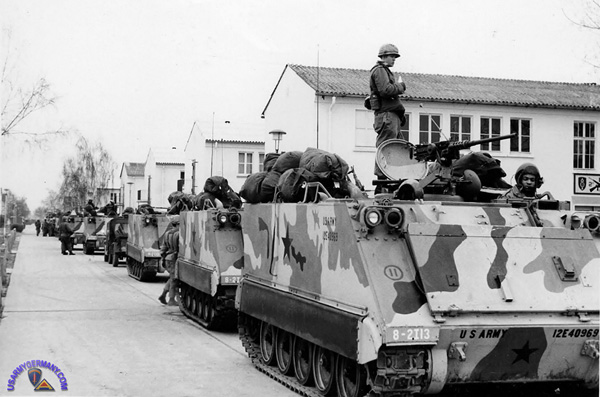 2nd Bn, 13th Infantry at Coleman Barracks, 1973 (Chuck Webster) |
||||||||||||||||||||||||||||||||||||||||
| 1974 | ||||||||||||||||||||||||||||||||||||||||
|
||||||||||||||||||||||||||||||||||||||||
| (Source: 8th ID(M) Welcome Pamphlet published around 1974) | ||||||||||||||||||||||||||||||||||||||||
| ORGANIZATION (1974): | ||||||||||||||||||||||||||||||||||||||||
|
||||||||||||||||||||||||||||||||||||||||
| 1980 | ||||||||||||||||||||||||||||||||||||||||
| (Source: USAREUR Telephone Directory - Troop Units, Spring 1980) | ||||||||||||||||||||||||||||||||||||||||
| ORGANIZATION (Spring 1980): | ||||||||||||||||||||||||||||||||||||||||
|
||||||||||||||||||||||||||||||||||||||||
| Division Artillery | ||||||||||||||||||||||||||||||||||||||||
|
||||||||||||||||||||||||||||||||||||||||
| 1956 | ||||||||||||||||||||||||||||||||||||||||
| (Source: US Army STATION LIST, 15 Aug 1956) | ||||||||||||||||||||||||||||||||||||||||
| ORGANIZATION (Aug 1956): | ||||||||||||||||||||||||||||||||||||||||
|
||||||||||||||||||||||||||||||||||||||||
| (1) reorganized and redesignated as 1st FA Bn (Rkt/How), 28th Arty while in Göppingen (2) reorganized and redesignated as 1st How Bn, 2nd Arty while in Neu Ulm |
||||||||||||||||||||||||||||||||||||||||
| (Source: Email from John Propelka) | ||||||||||||||||||||||||||||||||||||||||
| From April 1959 to July 1960, I served in D Battery (Honest John), 1st FA Bn, 28th Artillery at Ernst Ludwig Kaserne in Darmstadt.
We were detached from the other batteries which were located in Baumholder. Our other batteries were 105 or 155 mm units. Other units in our Kaserne were 16th FA Bn with 8" towed howitzers and 38th FA Bn with 280mm cannons. As a young shooter and engineering student, this made for a very interesting duty station! Reference Harald's M-125 truck comments: The 16th received these trucks to replace the M-8 tractors while I was there. We heard this was to speed travel and reduce road damage. We also heard that some M-8s were retained because the M-125s could get stuck on wet grass and needed help! I found your site while looking for buddies from my old unit. No luck here,but you have a very interesting site which brought many fond memories. Keep up the good work. |
||||||||||||||||||||||||||||||||||||||||
|
||||||||||||||||||||||||||||||||||||||||
| 1960 | ||||||||||||||||||||||||||||||||||||||||
| (Source: USAREUR STATION LIST, 31 Dec 1960) | ||||||||||||||||||||||||||||||||||||||||
| ORGANIZATION (Dec 1960): | ||||||||||||||||||||||||||||||||||||||||
|
||||||||||||||||||||||||||||||||||||||||
| (1) 105mm / 155mm SP | ||||||||||||||||||||||||||||||||||||||||
| (2) 8in / HJ | ||||||||||||||||||||||||||||||||||||||||
| Webmaster note: were the SW warheads for the 8th Inf Div Arty located at NATO Site 31, Wackernheim/Ober Olm in the 1960s? | ||||||||||||||||||||||||||||||||||||||||
| DivArty ROAD Changes (1963) | ||||||||||||||||||||||||||||||||||||||||
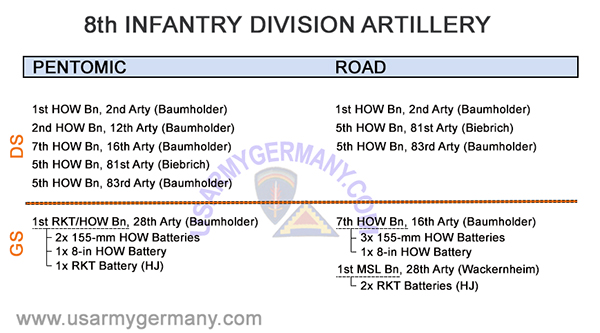 |
||||||||||||||||||||||||||||||||||||||||
| 1967 | ||||||||||||||||||||||||||||||||||||||||
| (Source: USAREUR STATION LIST, 30 June 1967) | ||||||||||||||||||||||||||||||||||||||||
| ORGANIZATION: | ||||||||||||||||||||||||||||||||||||||||
|
||||||||||||||||||||||||||||||||||||||||
| (1) 105mm SP | ||||||||||||||||||||||||||||||||||||||||
| (2) 155mm SP | ||||||||||||||||||||||||||||||||||||||||
| (3) 155mm / 8in SP | ||||||||||||||||||||||||||||||||||||||||
| (4) Honest John | ||||||||||||||||||||||||||||||||||||||||
| (Source: Email from Harold Murray) | ||||||||||||||||||||||||||||||||||||||||
| I was a member of the 7/16th Artillery in Baumholder, Germany, from March 1967 until October 1968. I was also a member of the boxing team and the track team. I won a medal in the boxing team & one first place on the track team (hammer throw). I worked at the EM Club as assistant manager under Sergeant Portis. Was in the band that won first place in a music competition. We won an all expenses paid trip to Garmisch but I had to work, so the rest of the group went and I did not. I had to work at the EM Club, not Duty, as I was excempt from regular army duty. |
||||||||||||||||||||||||||||||||||||||||
| 1980 | ||||||||||||||||||||||||||||||||||||||||
| (Source: USAREUR Telephone Directory - Troop Units, Spring 1980) | ||||||||||||||||||||||||||||||||||||||||
| ORGANIZATION (Spring 1980): | ||||||||||||||||||||||||||||||||||||||||
|
||||||||||||||||||||||||||||||||||||||||
| 1982 | ||||||||||||||||||||||||||||||||||||||||
| (Source: COMMUNITY NEWS, May 14, 1982) | ||||||||||||||||||||||||||||||||||||||||
| Field Artillery - "Outstanding'', "excellent" describes units by Kathy Bonney and John Falkenbury Over the last five months the Baumholder Military Community has undergone the most critical, technical inspection given to field artillery units, the Technical Validation Inspection (TVI). This year-round inspection is given to nuclear capable units and it is one of the few zero-defect inspections left in the Army. The nuclear surety program in Baumholder is controlled and supported by the community as a whole and executed by the field artillery battalions. In order to successfully complete the TVI a wide range of community support is required. To facilitate quality assurance, a nuclear surety board for the military community meets quarterly. This board, under the auspices of Community Commander Brig. Gen. Dave R. Palmer and chaired by the 8th Infantry Division Artillery Commander, Col. Dennis J. Reimer, consists of representatives from DIVARTY, 257th Personnel Company, 766th Med. Det. (DS), Community Counseling Center, 30th Field Hospital, 708th Maint. Bn., Directorate of Engineering and Housing, Security Plans and Operations, field artillery battalions and 5th Bn 6th ADA (3rd Bn 59th ADA). This board discusses how the nuclear surety program will be maintained throughout the community and implements any changes or recommendations which will uphold the recognized high standards. |
||||||||||||||||||||||||||||||||||||||||
| Lineage Data for Field Artillery Units assigned to DivArty (1956 thru early 1970s) | ||||||||||||||||||||||||||||||||||||||||
| At the time (1956) of the 8th Inf Div deployment to Germany as part of Operation GYROSCOPE, Division Artillery was organized under the 1948 Tables with three towed 105mm howitzer battalions (43rd,45th, 56th), one towed 155mm howitzer battalion (28th) and one antiaircraft artillery battalion (23rd). | ||||||||||||||||||||||||||||||||||||||||
| 28th Field Artillery Battalion | ||||||||||||||||||||||||||||||||||||||||
| (Source: Field Artillery, compiled by Janice E. McKenney, 1992, ARMY LINEAGE SERIES) | ||||||||||||||||||||||||||||||||||||||||
The 28th Field Artillery Battalion was an element of the 8th Infantry Division in 1955 and transferred from Fort Carson, Colorado to Schwäbisch Gmünd, Germany in 1956 as part of Operation GYROSCOPE (Shipment #4888).
|
||||||||||||||||||||||||||||||||||||||||
| 43rd Field Artillery Battalion | ||||||||||||||||||||||||||||||||||||||||
| (Source: Field Artillery Battalions of the US Army, Vol. 1, compiled and edited by James A. Sawicki, 1977) | ||||||||||||||||||||||||||||||||||||||||
| The 43rd Field Artillery Battalion was an element of the 8th Infantry Division in 1955 and transferred from Fort Carson, Colorado to Neu Ulm, Germany in 1956 as part of Operation GYROSCOPE (Shipment #4888). The battalion was relieved from the 8th Infantry Division and inactivated in Germany, 1 August 1957. On 1 August 1957, 1st How Bn, 2nd Arty was activated at Nelson Barracks, Neu Ulm and assigned to the 8th Infantry Division.
|
||||||||||||||||||||||||||||||||||||||||
| 45th Field Artillery Battalion | ||||||||||||||||||||||||||||||||||||||||
| (Source: Field Artillery Battalions of the US Army, Vol. 1, compiled and edited by James A. Sawicki, 1977) | ||||||||||||||||||||||||||||||||||||||||
| The 45th Field Artillery Battalion was an element of the 8th Infantry Division in 1955 and transferred from Fort Carson, Colorado to Neckarsulm, Germany in 1956 as part of Operation GYROSCOPE (Shipment #4888). The battalion was relieved from the 8th Infantry Division and inactivated in Germany, 1 August 1957. |
||||||||||||||||||||||||||||||||||||||||
| 56th Field Artillery Battalion | ||||||||||||||||||||||||||||||||||||||||
| (Source: Field Artillery Battalions of the US Army, Vol. 1, compiled and edited by James A. Sawicki, 1977) | ||||||||||||||||||||||||||||||||||||||||
| The 56th Field Artillery Battalion was an element of the 8th Infantry Division in 1955 and transferred from Fort Carson, Colorado to Schwabach, Germany in 1956 as part of Operation GYROSCOPE (Shipment #4888). The battalion was relieved from the 8th Infantry Division and inactivated in Germany, 1 August 1957. |
||||||||||||||||||||||||||||||||||||||||
| In 1957, the 8th Infantry Division was reorganized under the ROCID Division "test" tabels - with one 105mm direct-support artillery battalion (1st How Bn, 2nd Arty) and one general-support artillery battalion (1st Rkt/How Bn, 28th Arty). In 1960, the Division Artillery was reorganized under the "final" ROCID tables: now each battle group received a direct-support artillery battalion, necessitating the addition of four new composite (105mm & 155mm) artillery battalions to the DivArty organization (2nd How Bn, 12th Arty; 7th How Bn, 16th Arty; 5th How Bn, 81st Arty; 5th How Bn, 83rd Arty). |
||||||||||||||||||||||||||||||||||||||||
| 2nd Battalion, 12th Field Artillery | ||||||||||||||||||||||||||||||||||||||||
| (Source: Field Artillery, compiled by Janice E. McKenney, 1992, ARMY LINEAGE SERIES) | ||||||||||||||||||||||||||||||||||||||||
2nd Howitzer Battalion, 12th Artillery was assigned to the 8th Infantry Division and activated in Baumholder, Germany on 1 May 1960. |
||||||||||||||||||||||||||||||||||||||||
| 7th Battalion, 16th Field Artillery | ||||||||||||||||||||||||||||||||||||||||
| (Source: Field Artillery, compiled by Janice E. McKenney, 1992, ARMY LINEAGE SERIES) | ||||||||||||||||||||||||||||||||||||||||
7th Howitzer Battalion, 16th Artillery was assigned to the 8th Infantry Division and activated in Baumholder, Germany on 1 May 1960. The battalion was relieved from the 8th Infantry Division and inactivated in Germany, 13 September 1972. |
||||||||||||||||||||||||||||||||||||||||
| 5th Battalion, 81st Field Artillery | ||||||||||||||||||||||||||||||||||||||||
| (Source: Field Artillery, compiled by Janice E. McKenney, 1992, ARMY LINEAGE SERIES) | ||||||||||||||||||||||||||||||||||||||||
5th Howitzer Battalion, 81st Artillery (1) was assigned to the 8th Infantry Division and activated in Gonsenheim (Mainz), Germany on 1 May 1960. The battalion was inactivated in Germany, 31 August 1973. |
||||||||||||||||||||||||||||||||||||||||
| 1977 | ||||||||||||||||||||||||||||||||||||||||
| 5th Battalion, 83rd Field Artillery | ||||||||||||||||||||||||||||||||||||||||
| (Source: Field Artillery, compiled by Janice E. McKenney, 1992, ARMY LINEAGE SERIES) | ||||||||||||||||||||||||||||||||||||||||
5th Howitzer Battalion, 83rd Artillery was assigned to the 8th Infantry Division and activated in Baumholder, Germany on 1 May 1960. The battalion was inactivated in Germany, 13 September 1972. |
||||||||||||||||||||||||||||||||||||||||
| 1st Battalion, 68th Armor | ||||||||||||||||||||||||||||||||||||||||
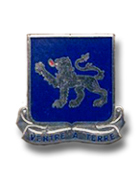 1st Bn, 68th Armor DUI 1st Bn, 68th Armor DUIOn 1 July 1957, The Combat Arms Regimental System (CARS) went into effect. Under CARS, the regimental system was reestablished, through name only, in an attempt to retain the continuity of history which has been lost during the rapid expansion of World War II. Under CARS, a regiment was formed, normally through reconsolidation of separate companies which were once members of the regiment before the war. In each case, a historical regiment was recreated rather than a new one formed. The regimental headquarters was retained under the Department of the Army control with ultimate goal of establishing a ceremonial headquarters and staff in Washington to display the honors of the regiment, though this has yet to be done. The other part of the plan called for each separate companies in the regiment to be redesigned Headquarters and Headquarters Company's of various battalions. Thus, a regiment had a potential for one battalion to for every company it once had. Then, when war demanded, as many battalions as were required became activated. The first letter company became the first battalion, thus the regiment was reconstituted as follows: Headquarters and Headquarters Company, 68th Armored battalion again became regimental Headquarters and Headquarters Company. A Company became 1st Battalion, B Company became 2nd battalion, and so on. Companies A through I became 1st through 9th Battalions respectively. The old reconnaissance company later D Troop, 68th Calvary Reconnaissance Squadron, became the 13th Battalion 68th Armor. Oddly G Company became 8th Battalion while H Company became 7th Battalion. There is no provisions for a 10th, 11th, or 12th Battalion. Of the Battalions of the regiment, the 1st through the 5th are currently on duty with the active army. The remainder are either in reserve units of inactive. Being descended from "A" Company, the unit became the 1st Medium Tank Battalion (Patton), 68th Armor, assigned to the 3rd Infantry Division at Fort Benning, Georgia; the some place where it first joined the 68th Armor. The battalion began its current history on 1 July 1957 when the line companies were activated, there being five in number under then current Pentomic Concept. 24 April 1958, the 3rd Infantry came to Germany, the 1st Battalion going to Aschaffenburg. Finally, in 1963, in conjunction with adoption of the ROAD concept, the unit was relieved from assignment to the 3d Infantry Division; concurrently redesignated as the 1st Battalion, 68th Armor, and assigned to the 8th Infantry Division. Consolidated with other battalions of the 68th Armor in the 8th Division, 1st Bn arrived at Baumholder on 1 April 1963. While stationed at Wildfecken, Germany, the Battalion began fielding the M1A1 Abrams MBT in the late 1980s, replacing its inventory of M60A3 tanks. |
||||||||||||||||||||||||||||||||||||||||
|
||||||||||||||||||||||||||||||||||||||||
| Photos are probably from the early 1960s | ||||||||||||||||||||||||||||||||||||||||
| ADDITION: (Source: Email from Tom Hamner) In Sept 1960 I was assigned to the 68th Armored and was returned to the US on Jan 1, 1963. I was in HQ company of the 68th Armored. Your write up puts the 68th Armored arriving in Baumholder in 1963. Believe me, I backed up to Baumholder (by train) from Div HQ in Bad K. Just like thousands of GI's we probably would have preferred to have been were you said we were -- but I bet all of us are proud of our time spent in Baumholder. I was in the 2nd Bn of the 68th Armored. I believe that the 1st Bn, 68th Armored was moved to Baumholder in 1963 |
||||||||||||||||||||||||||||||||||||||||
| 2nd Battalion, 68th Armor | ||||||||||||||||||||||||||||||||||||||||
 2nd Bn, 68th Armor DUI 2nd Bn, 68th Armor DUI |
||||||||||||||||||||||||||||||||||||||||
| 1965 | ||||||||||||||||||||||||||||||||||||||||
| (Source: Email from Tom Wilson) | ||||||||||||||||||||||||||||||||||||||||
| NAHBOLLENBACH DEPOT This remembrance is about the Nahbollenbach Supply Depot AND the 2/68 Armor stationed at Baumholder. The following incident took place in the spring or early summer of 1965. It’s been over 51 years and most of what follows was never documented in any of my records. Nahbollenbach’s security force at the beginning of 1965 was a private paramilitary group composed, I think, of mostly Czechs. As a cost cutting measure, this force was let go and the depot security was to be provided at least partly by Army units from Baumholder. I’m not sure if only units from the 8th. Infantry Division were tasked for this or if others such as the 3rd. ACR were also dragged in. I was XO of A Company, 2/68 ARMOR at the time and had duty as Officer of the Guard when my company was tasked to provide security. The property consisted of the warehousing and supply area on the lower level across the road from the Nahe River and a separate secured area on the hill above the main depot where wheeled vehicles of 2nd (?) Armored Division from Fort Hood were stored to be used during REFORGER. There were so many guard posts that we had to have additional help from other units in the battalion. There was an old building in the upper area where anyone off duty could eat, sleep, and escape the elements. Our “official” contact for security at the depot were MP’s from Strassburg Kaserne in Idar-Oberstein. Most of the time this was in the person of an MP Corporal driving a ¾ ton truck. One day we noticed a caravan of Gypsies driving Mercedes and pulling house trailers had moved onto the beach next to the Nahe across the road and had set up a camp. Shortly after their arrival, the German Polizei arrived in the green VW beetle to “register” the people in the camp. That night I was in the upper area in our shelter playing cards with some of off duty guys when I got a call from the sergeant of the guard insisting that I needed to immediately come down to see him in the lower part of the depot. He wouldn’t tell me what was going on but was so insistent that I got a jeep and went down there. When I arrived there, I was told that one of our guards had seen someone on the wire fence surrounding the facility and fired a few shot at them from his M-14. I think that the halt..halt…halt challenge was done very quickly before the shots were fired. I then had to call our MP contacts to tell them what happened and the first comment was “if your guy hit him and he’s outside the wire, go out and throw the body back inside!” Fortunately, no one was hit. The MP’s called the German police and both parties met me at the front of the depot. Our MP Corporal contact said that the 2 German police were afraid to go alone into the Gypsy camp in at night and would we provide them an escort. So we did, 2 MP’s and 2 of our jeeps with 6 or 8 of us went charging into the camp. Armed to the teeth. The folks in the camp were sitting around some fires and were very nonchalant about whatever was going on. All the police found was that there were 2 young men missing who supposedly had gone to the movies. End of the excitement for the evening…..well not for me. I went out to inspect the guards after that incident and checked one of the guys from my company at the rail entrance to the depot. He gave me such a halfhearted challenge that I got on him to make it sound like he meant business by shouting out the challenge, pulling my 45 and charging it, and then pointed it down at the ground near my foot when I pulled the trigger. I forgot that I put a full magazine in the pistol after the early excitement. Fortunately, I missed my foot. But then we heard some shouts and looked down the hill to see our company mechanics on roving jeep patrol with a bunch of M-14’s pointed at us. No shots fired after they figured out who we were. And then there was the anticlimax when we got back to Baumholder; we couldn’t find one of the M-14’s and everybody got confined to the battalion area for something like 6 or 8 hours. I seem to remember that the rifle was left on top of a jeep roof and was found along the road. The best thing was that we never had to mount guard at Nahbollenbach again. I have no idea what happened after our “tour”. The next best thing was that none of the officers in the battalion found out about my pistol discharge or I never would have heard the end of it. I guess I was okay with the guys in the company. |
||||||||||||||||||||||||||||||||||||||||
| 3rd Battalion, 68th Armor | ||||||||||||||||||||||||||||||||||||||||
 3rd Bn, 68th Armor DUI 3rd Bn, 68th Armor DUI |
||||||||||||||||||||||||||||||||||||||||
| 1965 | ||||||||||||||||||||||||||||||||||||||||
| (Source: Email from Wes Montgomery) | ||||||||||||||||||||||||||||||||||||||||
| The pictures were taken behind Sullivan Barracks in Mannheim, Germany. It was a somewhat small (local) training area, but large enough to run field problems with our tanks. The training area was officially named the Victor Area, but everyone called it the "V" area. The pictures were taken in 1965/1966. | ||||||||||||||||||||||||||||||||||||||||
|
||||||||||||||||||||||||||||||||||||||||
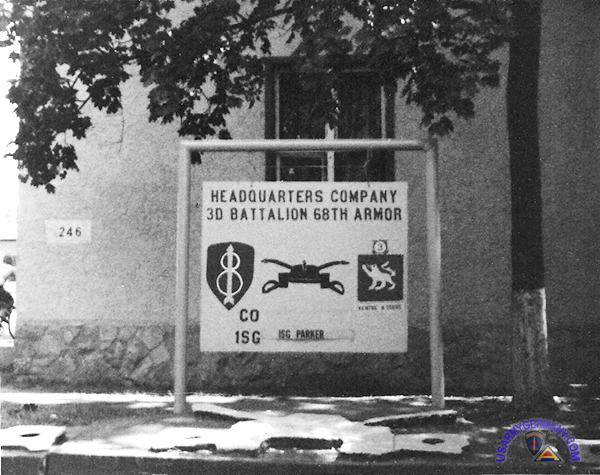 Sign in front of HHC barracks, Sullivan Barracks, 1976 |
||||||||||||||||||||||||||||||||||||||||
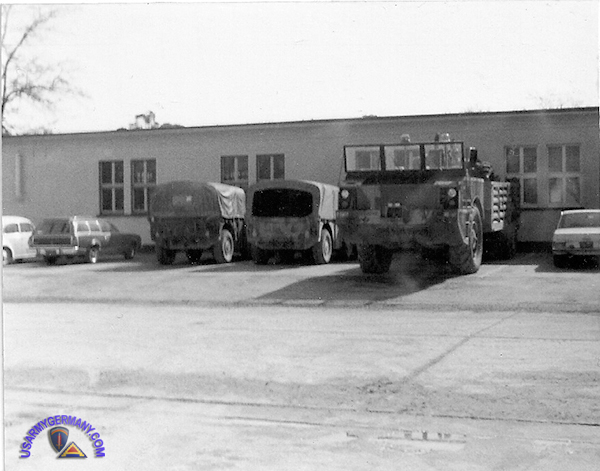 A GOER wrecker parked in front of the Bowling Alley, Sullivan Barracks |
||||||||||||||||||||||||||||||||||||||||
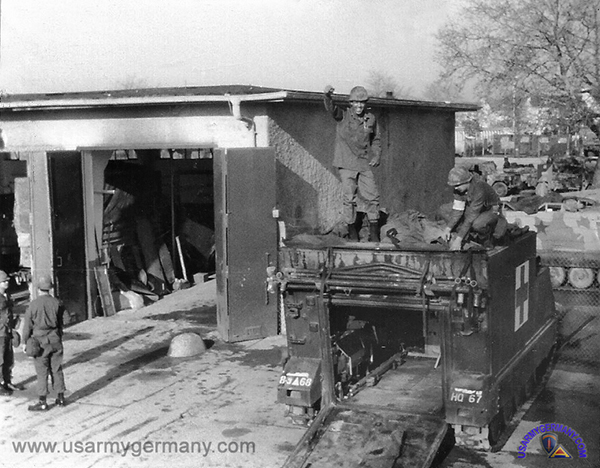 HHC Medics in the unit's motor pool at Sullivan Barracks, 1976 |
||||||||||||||||||||||||||||||||||||||||
| 1976 | ||||||||||||||||||||||||||||||||||||||||
| (Source: Email from Terry L. Duncan) | ||||||||||||||||||||||||||||||||||||||||
| I was stationed at Sullivan Barracks from 1976-1978. I have some pictures from when I was stationed in Mannheim with 3rd and 68th Armor. I was in HHC company maintenance. I drove the M-553 Goer wrecker recovery vehicle. | ||||||||||||||||||||||||||||||||||||||||
| 5th Battalion, 68th Armor | ||||||||||||||||||||||||||||||||||||||||
 5th Bn, 68th Armor DUI 5th Bn, 68th Armor DUI |
||||||||||||||||||||||||||||||||||||||||
| (Source: ARMOR-CAVALRY, Part I, by Mary Lee Stubbs & Stanley Russel Connor, Army Lineage Series) | ||||||||||||||||||||||||||||||||||||||||
| 5th Battalion, 68th Armor, at the time inactive and allotted to the Army Reserve, was activated on 1 April 1966 and concurrently assigned to 8th Infantry Division. | ||||||||||||||||||||||||||||||||||||||||
| 1976 | ||||||||||||||||||||||||||||||||||||||||
| (Source: Email from Lloyd B. Raeg) | ||||||||||||||||||||||||||||||||||||||||
| Would you please add and update your information pertaining to the units that were equipped with the M60A2 Tanks. I was stationed at Sullivan Barracks 1976-79 when we received and fielded the M60A2 Tanks. I believe we received our M60A2's in late 1977. Before I left Germany in Jul 1979, we were getting the M60A1 Rise. The 3rd Bn 68th Armor was also located at Sullivan Barracks. I don't know much about them. For your information, I went through the M60A2 Armor Crewman Course from 26 Apr -14 May 76. I also did two tours in Viet Nam (67-68) with the Navy SeaBee's and another 13 years in the in the ARG (Active/Guard Reserve program with California Army Nation Guard and retired from active duty in May 1995. |
||||||||||||||||||||||||||||||||||||||||
| 1982 | ||||||||||||||||||||||||||||||||||||||||
| (Source: Email from John W. Faulconbridge, CO of "D" Company) | ||||||||||||||||||||||||||||||||||||||||
| I served with the “Grey Lions” from December of 1982 thru January 1986. We were at Sullivan Barracks, Mannheim. The Headquarters Building was shared with 3-68. (I think it’s building 236 on the map. Building 239 was the Chapel.) The Battalion was initially organized with 3 tank companies of 17 M60A1 RISE/Passive tanks each, a Combat Support Company with Scout and Mortar Platoons and a Headquarters/Headquarters Company (Staff and maintenance). In 1983 we underwent the transition to the “Division ‘86” structure which meant 4 tank companies of 14 M60A3 TTS tanks and a Headquarters/Headquarters Company. The HHC incorporated the Scout and Mortar platoons along with the staff and maintenance elements. The battalion participated in numerous training exercises both at the major training areas (Baumholder, “Graf” and Hohenfels) and in maneuver training areas. We were involved in REFORGER ’83 and ’85 as players. I was the Commander of D Company in 1983-84. |
||||||||||||||||||||||||||||||||||||||||
| 1984 | ||||||||||||||||||||||||||||||||||||||||
| (Source: Email from Stevie Jones) | ||||||||||||||||||||||||||||||||||||||||
First let me say thank you for the wonderful site.
However I was disappointed to see that 8th ID 5th Bn 68th Armor was not listed.
We were also on Sullivan Barracks in Mannheim and battle with 3rd Bn 68th Armor. Later 3/68 became 5/77 Armor and 5/68 became 3/77 armor are maybe it was vice versa. Please menton 5/68th Armor Grey Lions. |
||||||||||||||||||||||||||||||||||||||||
| 1st Battalion, 87th Infantry | ||||||||||||||||||||||||||||||||||||||||
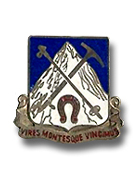 1st Bn, 87th Inf DUI 1st Bn, 87th Inf DUIThe 87th Infantry was assigned to the 10th Infantry Division on 18 June 1948, reactivating at Fort Riley, KS. In preparation for the Korean War, 1-87 became part of three regiments that trained 123,000 men in basic training. In January 1954, the Department of the Army announced that the 10th Division would become a combat infantry division, and be the first sent to Europe under a new rotation policy (GYROSCOPE). In June 1958, the 87th Infantry Regiment was reassigned from the 10th Division to the 2nd Infantry Division as the 1st and 2nd Battalions, 87th Infantry. The battalions remained in the 2nd Infantry Division until 4 September 1963, when it was reassigned to the 8th Infantry Division in Germany. 1-87 was stationed in Jaeger Kaserne, Aschaffenburg, and was assigned to NATO land forces in central Europe. On June 14, 1958, the 10th Division was inactivated. However 1-87 and 2-87 were assigned to the 8th Infantry Division in Germany until September 1963 and remained on active duty in Germany until 1 October 1983 when they were inactivated. |
||||||||||||||||||||||||||||||||||||||||
| 1963 | ||||||||||||||||||||||||||||||||||||||||
| (Source: Email from Ralph Lohmann) | ||||||||||||||||||||||||||||||||||||||||
| In your series of photographs (see photo #7 below) from the 1st Battalion, 87th Infantry, you questioned the caption of one of what might or might not have been the motor pool of B Co. I was the Platoon Leader of the First Platoon of C Company for about nine months from 1963 to 1964. If I recall correctly, the photograph is of the Battalion motor pool. (Certainly the variety of vehicles parked there far exceeded the TO&E allowance of a mech infantry company of that era.) I don't believe the companies had motor pools. The track with B Co markings in photo 5 had probably been in the Battalion motor pool because it was on deadline or for some directed modification. The companies parked their tracks across the street (New-York Straße, I think) from the barracks as shown in photo number 3 of the series, and put their other vehicles down in the Battalion motor pool. With respect to the dates of the photographs, you are correct in supposing that that they date from the 1960s. The style of the bumper numbers is consistent with the pattern used in that period. The soldiers in the pictures are wearing fatigue caps of a style introduced in early 1963. Consequently, given the fatigues and vegetation, the pictures can't be earlier than the summer of that year. The not-later-than date is a little trickier. The markings on the sides of the M-113s in photo 3 are unfamiliar to me, which means that they were put there at some point after I left the Division in September of 1966. They replaced a three-digit unit number, each digit roughly a foot high. (Mine was 311; C [3] Company, First Platoon, Track 1). I don't know how long after September of 1966 the change was made, but a dark-painted area on the track in photo number 5 covers the exact area where the old numbers would have been; the new hexagonal marking is painted over it. The haircuts seem a bit longer than I remember them, but shorter than would permitted a few years later. Given all of the above, my guess is the the photographs date from the summer of 1967. I have a somewhat hair-raising war story of my 1/87 days that you might want to add to the page. There was considerable tension back then between the 8th Division (2nd Brigade and DivArty) troops and the USAREUR garrison MPs. I would regularly get DRs that the MPs had slapped on my people for allegedly disorderly conduct downtown. Knowing the soldiers involved, I was pretty sure that well over half of the DRs were unwarranted. I had several unpleasant discussions with the Provost Marshal, whose name I withhold to protect the guilty, discussions that got me nowhere. There was nothing much I could do about it, except complain (equally uselessly) to the Battalion Commander, until one day (probably in January of 1964) I happened to be in the Commissary where two MPs were sitting at a desk checking IDs. As I went out, I noticed that their quarter-ton did not have the lock and chain around the steering wheel. I was shocked --shocked!-- to see a military-police vehicle unlocked and unattended with all those Russian SMLM vehicles cruising around. The Russians could have stolen it and taken it to East Berlin or Moscow. With a youthful sense of invulnerability (or maybe of borderline insanity), I got into the vehicle, drove it to the 1/87 motor pool, then called the Provost Marshal to tell him that I had secured his unlocked and unattended vehicle, and that he should send someone to police it up. Amazingly, nothing happened to me. Except.... From the next day until I left Baumholder in February of 1966, an MP quarter-ton followed me everywhere I went on the installation; a peculiarly malign escort service. Because of that, I made sure that I drove one Km/h below the speed limit at all times, made sure the snow was brushed off my license places (they liked to hand out DRs for snow on license plates), and generally cultivated a cheerful paranoia behind the steering wheel. They never caught me. |
||||||||||||||||||||||||||||||||||||||||
| (Source: Credentials, July 11, 1983) | ||||||||||||||||||||||||||||||||||||||||
| 1st Bn., 87th Inf, deactivates to Mainz By Jim Goodin The 1st Battalion, 87th Infantry's deactivation/restationing process neared completion, as Combat Support Company's scout platoon became 1st Brigade's Headquarters and Headquarters Scout Platoon and moved to Mainz July 1. The battalion was deactivated and the colors retired in a ceremony in Baumholder May 12, under a drizzly, overcast sky. Lt. Col. Charles H. Baumann, commander of the battalion was reviewing officer and a speech was made by Maj. Gen. Carl E. Vuono, then commander of 8th Infantry Division (Mech). It was the first battalion in the division to be deactivated as part of the Division's change to the Division 86 structure. Known as a "bill paying unit," the battalion's troops and equipment will be used to increase the size of the battalions remaining active, thus allowing for complete reorganization, while maintaining the required manpower ceiling. The concept of Division 86 has been established to gain maximum advantage from new weapon systems and equipment; it will also enable the Army to make better use of training and living areas in Germany. B Co. in the battalion was the first unit to relocate to Mainz, becoming D Co., 2nd Bn., 87th Inf. on June 1; C Co. moved June 20 to become D Co. 2nd Bn., 28th Inf. The 1st Bn., 87th Inf. Regiment was constituted on Nov. 15, 1941, at Fort Lewis, Wash., as part of the 87th Inf. Mountain Regiment. In 1948, it was redesignated as a regular Army battalion as part of the 10th Inf. Div., Fort Reily, Kan. On April 19 1963, the battalion was assigned to the 2nd Brigade, 8th Inf. Div. where it has proudly served since. The deactivation of the 1st Bn., 87th Inf. will continue when A Co. moves to Mainz on July 10 to become D Co., 2nd Bn., 13th Inf. The remainder of the battalion will be moved to various surrounding support units. |
||||||||||||||||||||||||||||||||||||||||
|
||||||||||||||||||||||||||||||||||||||||
| Photos to be added are probably from the 1960s | ||||||||||||||||||||||||||||||||||||||||
| 2nd Battalion, 87th Infantry | ||||||||||||||||||||||||||||||||||||||||
| (Source: Email from Larry N. Osborne) | ||||||||||||||||||||||||||||||||||||||||
| I was looking at the 8th Div. web page and checked out the info on my old unit, the 2nd of the 87th Inf. I have a couple of comments. First, I think the 2nd arrived in Germany in the Fall/Winter of 1963 to replace the 2nd of the 9th. I arrived in December 1963, and we were still sharing barracks with the 2nd of the 9th. We were stationed in Sullivan Barracks, located in Kaefertalwald, outside Mannheim. I'm not sure if the 1st used the same DUI, but the vires montesque vincimus one was definitely ours. It replaced a locally created one with "we conquer men and mountains" on it. Because of the way training and assignment was done in those days (draft intakes tended to remain together) there was a large Hawaiian contingent in the unit. I remember watching them see snow for the first time in Winter '63. The unit was going to be returned to CONUS for additional training and reassignment in late spring/early summer 1966 (eventually Vietnam bound, I believe), but since I was due to be released in May, in the words of the SMaj, "if you don't reenlist you won't be able to go back to the US with the unit." So they discharged me 6 weeks early and I never got the chance to see beautiful SE Asia. That doesn't seem to square with the "remained on active duty in Germany until 1983" line. But since I was sent home, I can't confirm the unit returned in '66. |
||||||||||||||||||||||||||||||||||||||||
| (Source: Email from Tom Early, 2nd Bn, 87th Inf, 1982-86) | ||||||||||||||||||||||||||||||||||||||||
| I would like to add to the info about 2-87IN, 8th ID. I arrived in August 1982 after basic training at Fort Knox. I served as a Cavalry Scout in the Scout Platoon of 2-87IN. We were part of the 1st Brigade, 8th ID, and stationed at Robert E. Lee Barracks, Mainz-Gonsenheim, Germany. In addition to 2-87IN the brigade had 2-28IN, 4-69AR, and 1-68AR which was located separately at Wildflecken. We trained mainly at Graf and at Hohenfels, with a trip to Baumholder for training alongside 2nd Brigade which was stationed there. 3rd Brigade was in Mannheim, AVN Brigade at Mainz-Finthen Army Airfield, and the 8th DIV HQ was still in Bad Kreuznach. I was stationed with 2-87IN in Mainz from Aug 1982 until February 1986 when I was transferred to the 24th ID at Fort Stewart. I remember 2-87IN was due to re-flag as 5th Battalion 8th Infantry Regiment around June 1986 because all the 87th Infantry Regiments battalions colors were going to 10th Mountain Division. I hope this will be a good addition to what has been written on your page about 2-87IN. |
||||||||||||||||||||||||||||||||||||||||
| 1st Battle Group, 38th Infantry (ROTAPLAN) | ||||||||||||||||||||||||||||||||||||||||
| (Source: 1st Battle Group, 38th Infantry (ROTAPLAN), 15 Oct 1962-15 April 1963) | ||||||||||||||||||||||||||||||||||||||||
|
||||||||||||||||||||||||||||||||||||||||
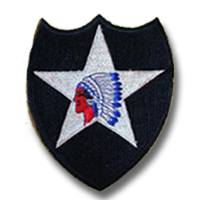 2nd Inf Div, Fort Benning, GA - CONUS parent unit of the 1st BG, 38th Inf 2nd Inf Div, Fort Benning, GA - CONUS parent unit of the 1st BG, 38th Inf |
||||||||||||||||||||||||||||||||||||||||
| 3rd Reconnaissance Squadron, 8th Cavalry | ||||||||||||||||||||||||||||||||||||||||
| 8th Reconnaissance Company | ||||||||||||||||||||||||||||||||||||||||
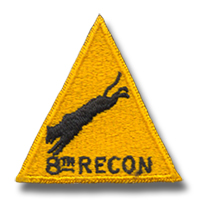 8th Recon Co Pocket Patch 8th Recon Co Pocket Patch |
||||||||||||||||||||||||||||||||||||||||
| (Source: Email from John Ackerman) | ||||||||||||||||||||||||||||||||||||||||
| Our 8th Recon Co. arrived at Merrell Barracks (Nürnberg) in September, 1956. We were there until approximately September, 1957. Then, our company was transferred to Johnson Barracks. We were at Fürth for only about 3 months. Then in November, 1957, our company, along with all the 8th Inf Div units stationed at Johnson, were transferred to Coleman Barracks in Mannheim. I don't know if there were any troops left at Johnson after the 8th Inf Div units left for Coleman.
The 8th Recon Co trained at Grafenwöhr and Hohenfels while we were stationed at Merrell Barracks and later at Johnson Barracks. I have some photos of that training. And yes, while we were stationed at Merrell, the 8th Recon Co., did pull border patrol at Camp Röhrnbach. We were at this assignment for about 30 days. I have a photo of me at the gate on guard duty. The 8th Recon Co. joined in other units of the 8th Inf Div on field maneuvers across southern Germany. Being a Recon Co, we covered a lot of territory on these training exercises. To the best of my knowledge, the 8th Recon Co. was the only Cavalry Troop assigned to th 8th Inf Div. You will probably be able to verify or dispel that thought. |
||||||||||||||||||||||||||||||||||||||||
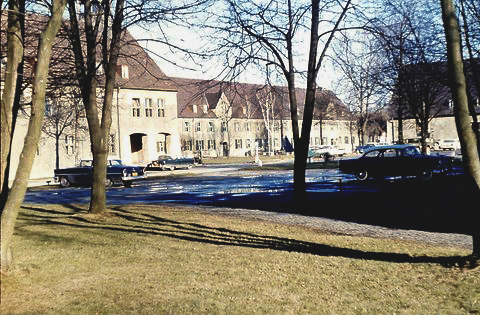 Fliegerhorst Kaserne, Leipheim, in the fall of 1957 |
||||||||||||||||||||||||||||||||||||||||
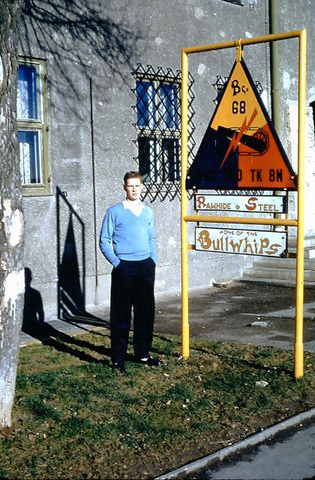 John Ackerman next to the B Co 68th Tank Bn sign at Fliegerhorst Kaserne, Leipheim |
||||||||||||||||||||||||||||||||||||||||
I played on a company level basketball team at Merrell, then on a battalion level basketball team at Johnson. The above photos were taken while we were at Leipheim when our basketball team went there for a tournament. Would be October, 1957. While in Germany, I visited a few kasernes, whose names I don't remember, when I visited my uncle who was a MSGT at the time, who also was with the 8th Inf. Div., in Field Artillery. One kaserne was in Ulm/Neu Ulm. Also, when we went to away football and basketball games. I also did a lot of traveling on my own while in Germany. I used the USO services extensively at Merrell to take monthly Sunday daytrips by bus to several areas of interest within 90 miles of Merrell Barracks. Great Education. I also took a 2 week tour from Munich by bus, through Austria, Italy, and Switz. And, I spent week in Paris. Never thought I would ever do those things in my lifetime, so I took advantage of all the travel I could afford. That's approx. 30 men per platoon. I could be off on headcount by 1 or 2. |
||||||||||||||||||||||||||||||||||||||||
|
||||||||||||||||||||||||||||||||||||||||
| 3rd Reconnaissance Squadron, 8th Cavalry - Johnson Barracks, Fürth | ||||||||||||||||||||||||||||||||||||||||
| 1957 | ||||||||||||||||||||||||||||||||||||||||
| (Source: Armor-Cavalry, Army Lineage Series, 1969) | ||||||||||||||||||||||||||||||||||||||||
| 3rd Reconnaissance Squadron, 8th Cavalry was activated in Germany on 1 August 1957 and assigned to the 8th Infantry Division. Concurrently, the squadron was consolidated with the 8th Reconnaissance Company. John Ackerman: This is when we changed patches from the Gold Triangle Panther patch to the Cavalry Pocket Patch. 8th Recon Co became C Troop, 3rd Recon Sq, 8th Cav. |
||||||||||||||||||||||||||||||||||||||||
| 3rd Reconnaissance Squadron, 8th Cavalry - Coleman Barracks, Mannheim-Sandhofen | ||||||||||||||||||||||||||||||||||||||||
| 1958 | ||||||||||||||||||||||||||||||||||||||||
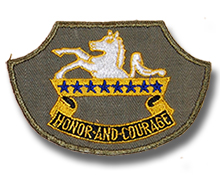 3rd Recon Sq, 8th Cav Pocket Patch 3rd Recon Sq, 8th Cav Pocket Patch |
||||||||||||||||||||||||||||||||||||||||
| (Source: Email from John Ackerman) | ||||||||||||||||||||||||||||||||||||||||
| There was a lot of reorganizing going on involving the 8th Inf Div. That was obvious to us soldiers by the 2 times our company was transferred in 4 months, but we didn't know just what was happening. I don't remember our ever being informed of the reorgs. I note the 8th Inf Div was gathered/stationed around Mannheim by late 1957, early 1958. |
||||||||||||||||||||||||||||||||||||||||
| 1958 | ||||||||||||||||||||||||||||||||||||||||
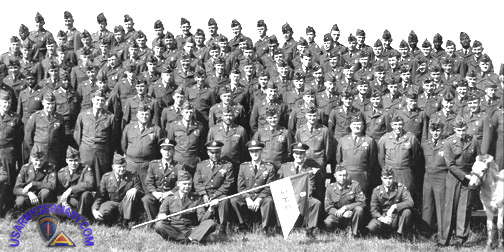 HQ&HQ Troop, 1958 |
||||||||||||||||||||||||||||||||||||||||
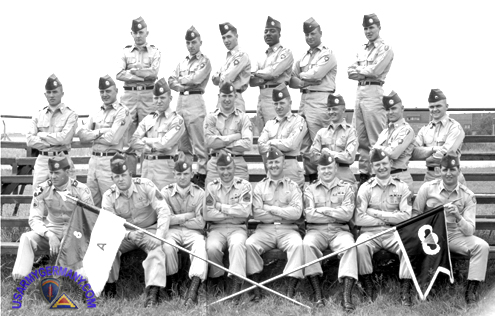 HQ Platoon, "A" Troop, 1959 |
||||||||||||||||||||||||||||||||||||||||
| (Source: Email from Edward G. Ogle, Sr.) | ||||||||||||||||||||||||||||||||||||||||
| My 1st Assignment, Hq & Hq Troop, 3rd Recon Sqdn, 8th Cav, 8th Inf. Div. 1958 - This uniform is better than those of today. (attached picture) 2nd assignment: A Troop (Airborne), 3rd Recon - 1959 (attached picture). We were the first airborne troops in Germany since WWII, and not the 504th or 505th. We received in-country training at Gablingen Kaserne, Augsburg, Germany 1959. There was our Recon Troop, an Infantry Company, an Artillery Company and I think a Combat Engineer Company. When moving on the ground we were regular Recon Cavalry. When in the air we were joined by the other companies and formed a battalion of Airborne. It was our job to secure bridge heads, and disrupt behind the lines, until ground forces arrived. When Airborne I was half of a 30 Cal light MG crew. I ran across my gun team partner again in Vietnam - what a surprise. As I remember, after we established, the 504th and 505th Airborne came over. Many units were coming in what was called "Operation GYRO" - where entire units were brought in to fill gaps or relieve other units returning to the states. That was soon, either abandoned or completed. When I left the latter part of 1962 there were no more units coming our way. A normal tour was 4 years max but many of us short-timers were extended 6 months because the East Germans (read Russians) decided to shut down ground access to Berlin again. This time the US said nope, it's not going to happen. I received the alert at about 0300 and by the time I arrived the 18th Infantry (also in Coleman Barracks, Sandhoffen) was moving out the gate. I realized this was no drill because all their external mounted 50s (the M2s) were loaded with live ammo. The 18th went to Berlin thru a gauntlet of T35s (Webmaster note: should be "T34s"?) or newer stuff, all along the way. I don't think many people in the States have a clue about this. This is also during JFK's time when American came really close to full scale war with the Soviet Union. Seems Russia would poke JFK in the eye and JFK would kick them in the balls. We have never been friends with Russia, we may never be, but we could always trust Russia to be an adversary in control of their stuff. Today, who knows? |
||||||||||||||||||||||||||||||||||||||||
| 3rd Squadron, 8th Cavalry | ||||||||||||||||||||||||||||||||||||||||
| 1962 | ||||||||||||||||||||||||||||||||||||||||
| (Source: Email from Jerry Smith, Troop A, 3rd Recon Squadron, 8th Cavalry, 1962-64) | ||||||||||||||||||||||||||||||||||||||||
| From: September 1962-1964 I was assigned to the 7th Army, 8th Infantry Division (Mech). Detached from the 509th Airborne (Mainz-Gonsenheim) to Troop A, 3rd Recon Squadron, 8th Cavalry (Mannheim-Sandhofen) and, if memory serves, after late 1963 it was changed to: Troop A, 3rd Bn, 8th Cav, can't remember for sure. Wing background was red over white split diagonally for our Cavalry unit; we were Airborne tankers, the only ones in the world at that time to my knowledge. I stayed on Jump Status during my tour. If the operation went Airborne we were assigned Jeeps with 106 Recoilless Rifles in place of M60 Tanks. I had various duties during the tour; recon took us to the borders many times using our Portable Radar units. Jeep Driver, Machine Gunner (jeeps) and Driver 114 Recon vehicles, 113 Personal Carrier Driver and Radar Operator and Driver - 3/4 (three-quarter) ton truck for the radar equipment also known earlier as a weapons carrier. During OPERATION BIG LIFT Troop A was assigned to Rhein-Main Air Base to direct and coordinate part of that operation, Might say we were traffic cops. I'm still digging up our unit insignias and trying to remember what I can during that period. Jerry Smith |
||||||||||||||||||||||||||||||||||||||||
| (Source: Email from Paul Cleary) | ||||||||||||||||||||||||||||||||||||||||
| This group of pictures should give you an idea of where "D" Troop was located on Coleman Barracks, Sandhofen. "A" Ttroop was in the four barracks located on the parade/ball field. I think the building #'s are 1400 to 1403. Additional photos submitted by Paul: |
||||||||||||||||||||||||||||||||||||||||
|
||||||||||||||||||||||||||||||||||||||||
| 1st Battalion, 59th Air Defense Artillery | ||||||||||||||||||||||||||||||||||||||||
| 1970 | ||||||||||||||||||||||||||||||||||||||||
| (Source: STARS & STRIPES, July 3, 1970) | ||||||||||||||||||||||||||||||||||||||||
| 1st Bn, 59th ADA is the first USAREUR unit to take their self-propelled Vulcan tracks to the German Army's ranges at Todendorf (on the coast of the Baltic Sea) for live firing training. The troops were billeted at Camp Danzig. Some 245 officers and enlisted men with 24 Vulcan tracks were deployed to Todendorf (most likey by rail). Each of the 24 four-man crews fired a total of practice 40 courses on air defense and low-level ground-fire targets before it was graded for the record. Supporting units for the practice period on the Todendorf ranges included: 1st Bn, 59th ADA arrived at Mainz eight months ago (Nov 1969). |
||||||||||||||||||||||||||||||||||||||||
| Related Links: |
||||||||||||||||||||||||||||||||||||||||
